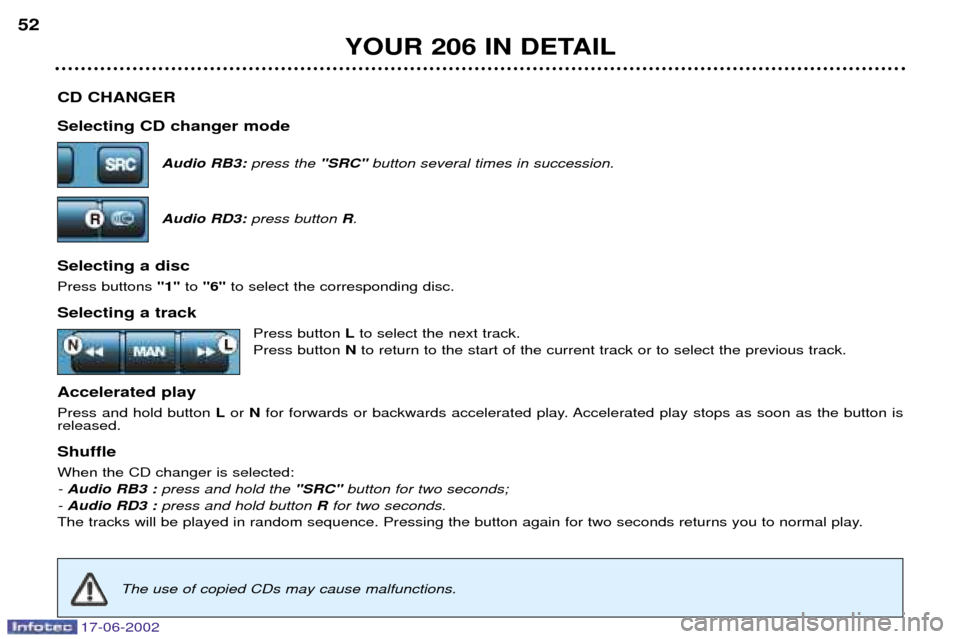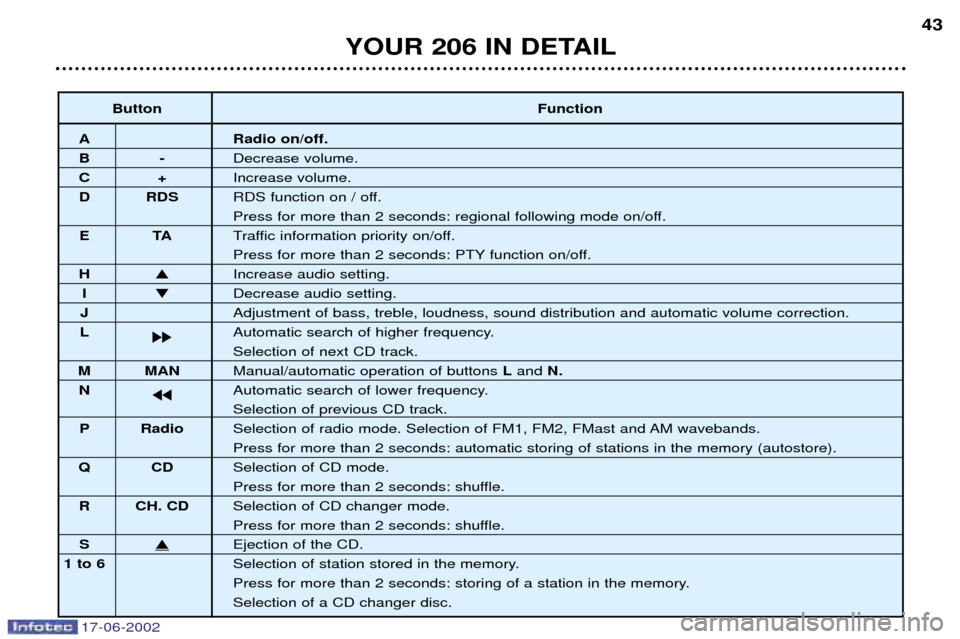Peugeot 206 SW Dag 2002 Service Manual
Manufacturer: PEUGEOT, Model Year: 2002, Model line: 206 SW Dag, Model: Peugeot 206 SW Dag 2002Pages: 155, PDF Size: 2.09 MB
Page 41 of 155

17-06-2002
Adjusting the bassWhen "BASS" is displayed, press button Hor Ito vary the setting.
- "BASS -9" for a minimum bass setting,
- "BASS 0" for a normal setting,
- "BASS +9" for a maximum bass setting.
Adjusting the treble When "TREB" is displayed, press button Hor Ito vary the setting.
- "TREB -9" for a minimum treble setting,
- "TREB 0" for a normal setting,
- "TREB +9" for a maximum treble setting.
Adjusting the loudnessThis function automatically emphasises bass and treble tones. Press button Hor Ito switch the function on or off.
Adjusting the front/rear sound distribution (Fader) When "FAD" is displayed, press button Hor I.
Button Hincreases the volume in the front.
Button Iincreases the volume in the rear.
Adjusting the right/left sound distribution (Balance)When "BAL" is displayed, press button Hor I.
Button Hincreases the volume on the right-hand side.
Button Iincreases the volume on the left-hand side.
Automatic volume correctionThis function enables the volume to be automatically adjusted depending on the level of noise produced by the speed of the vehicle. Press buttons Hor Ito switch the function on or off.
YOUR 206 IN DETAIL 45
Page 42 of 155

17-06-2002
RADIO Notes on radio reception
Your radio is subject to phenomena which do not affect domestic radio sets. Both AM (MW/LW) and FM reception are sub-
ject to various forms of interference. This is no reflection on the quality of the equipment, but is due to the nature of thesignals and the way in which they are transmitted.
On MW/LW, interference may be noticed when passing under high voltage power lines or bridges, or in tunnels.
On FM, interference may be the result of increasing distance from the transmitter, deflection of the signals by obstacles
(mountains, hills, buildings etc), or of being in an area which is not covered by a transmitter. Selecting radio modeAudio RB3:press button "SRC"several times in succession.
Audio RD3: press button P.
Selecting a waveband Audio RB3 : briefly press the "BND/AST" button to select the FM1, FM2, FMast and AM wavebands.
Audio RD3 : briefly press button Pto select the FM1, FM2, FMast and AM wavebands.
Automatic station search Briefly press button Lor Nto search for the station immediately above or below. By continuing to
press the button in the direction selected, you will obtain continuous scrolling of the frequency. The scrolling stops at the first station found as soon as the button is released.If the TAtraffic programme is selected, only stations broadcasting this type of programme are
selected.Searching for a station occurs first in "LO"sensitivity (selection of the most powerful transmitters) during scanning of the
waveband, then in "DX"sensitivity (selection of the weakest and most distant transmitters).
To make a direct search in "DX"sensitivity, press button Lor Ntwice.
YOUR 206 IN DETAIL
46
Page 43 of 155

17-06-2002
Manual station search Press the "MAN"button.
Briefly press button Lor Nto increase or decrease the frequency displayed.
By continuing to press the button in the direction selected, you will obtain continuous scrolling of the frequency. The scrolling stops at the first station found as soon as the button is released.Pressing the "MAN"button again returns you to automatic station search.
Manual storing of stations in the memory Select the station required. Press and hold one of the buttons "1"to "6" for more than two seconds.
The sound stops then becomes audible again, confirming that the station has been stored in the memory. Automatic storing of FM stations in the memory (autostore)
Audio RB3:press and hold the "BND/AST" button for more than two seconds.
Audio RD3: press and hold button Pfor more than two seconds.
Your radio automatically stores the six stations with the strongest signal in FM. These stations are stored in the FMast wave-
band.
If it is not possible to find six stations, the remaining memories are empty. Recalling stations stored in the memory For each waveband, briefly press buttons "1"to "6" to recall the corresponding station.
YOUR 206 IN DETAIL 47
Page 44 of 155

17-06-2002
RDS Using the RDS (Radio Data System) function on FM Radio Data System allows you to continue listening to the same station, whatever frequency it is using for the region you are going through.Briefly press the "RDS"button to switch the function on or off.
The multi-function display wil show: - "RDS" if the function is selected.
- "(RDS)" if the function is selected but not available.
RDS station following
The display indicates the name of the station selected. The radio is continually searching for the station which has the best reception and which is transmitting the same programme.
Traffic information programme Press the "TA"button to switch the function on or off.
The multi-function display will show: - "TA" if the function is selected,
- "(TA)" if the function is selected but not available.
Any traffic information flash will be given priority, whatever source you are listening to (radio, cassette or CD
changer).If you wish to interrupt a message, press the "TA"button; this switches the function off.
Note: the volume of traffic information announcements is independent of the volume of normal radio listening. You can adjust it using the volume button. The setting will be stored and will be used when the next messages arebroadcast.
Regional following mode When they are part of a network, certain stations broadcast regional programmes in the various areas they serve. With regio- nal following mode you can keep listening to the same programme. Press the "RDS"button for more than two seconds to switch the function on or off.
YOUR 206 IN DETAIL
48
Page 45 of 155

17-06-2002
CASSETTE: AUDIO RB3 Selecting cassette modeWhen a cassette is inserted, the cassette player will start automatically. If a cassette is already inserted, press the "SRC"button until cassette mode is selected.
Note: before inserting the cassette, ensure that the tape is taut.
Ejecting the cassette Fully press buttons Fand Gto eject the cassette from the player.
Direction of play
The player will play sides 1 and 2 of the cassette alternately, by automatically reversing the direction of play at the end of a
side.
To manually reverse the direction of play, press buttons Fand Ghalf-way.
Fast forward/rewind Fully press button For Gto fast forward or rewind the cassette. At the end of the fast forward/rewind, the set plays the cur-
rent side. Recommendations for using casssettes
- Use good quality cassettes.
- Avoid the use of cassettes which play for longer than 90 minutes.
- Never expose the cassettes to heat or the direct rays of the sun.
- Re-tighten the tape if necessary before inserting the cassette in the player.
- Clean the playing head regularly with a damp type cleaning cassette.
YOUR 206 IN DETAIL
50
Page 46 of 155

17-06-2002
CD CHANGER Selecting CD changer modeAudio RB3: press the "SRC" button several times in succession.
Audio RD3: press button R.
Selecting a disc Press buttons "1"to "6" to select the corresponding disc.
Selecting a track Press button Lto select the next track.
Press button Nto return to the start of the current track or to select the previous track.
Accelerated playPress and hold button Lor N for forwards or backwards accelerated play. Accelerated play stops as soon as the button is
released. Shuffle When the CD changer is selected: - Audio RB3 : press and hold the "SRC" button for two seconds;
- Audio RD3 : press and hold button Rfor two seconds.
The tracks will be played in random sequence. Pressing the button again for two seconds returns you to normal play.
YOUR 206 IN DETAIL
52
The use of copied CDs may cause malfunctions.
Page 47 of 155

17-06-2002
YOUR 206 IN DETAIL
42
AUDIO RD3
Stalk movement Function
1 - Press (behind) Increase volume
2 - Press (behind) Decrease volume
1 + 2 - Simultaneous press Sound cut-off (mute); restoring of the sound by pressing any button
3 - Press Automatic search of higher frequencies (radio)
Selection of the next track (CD)
4 - Press Automatic search of lower frequencies (radio)
Selection of the previous track (CD)
5 - Press the end Change of source (radio/CD/CD changer)
6 - Rotation Selection of next station stored in memory (radio)
(clockwise) Selection of next CD
7 - Rotation Selection of previous station stored in memory (radio)
(anti-clockwise) Selection of previous CD
Page 48 of 155

17-06-2002
YOUR 206 IN DETAIL43
Button Function
A Radio on/off.
B-Decrease volume.
C+Increase volume.
D RDS RDS function on / off.
Press for more than 2 seconds: regional following mode on/off.
ET ATraffic information priority on/off.
Press for more than 2 seconds: PTY function on/off.
H � Increase audio setting.
I� Decrease audio setting.
J Adjustment of bass, treble, loudness, sound distribution and automatic volume correction.
L kk Automatic search of higher frequency.
Selection of next CD track.
M MAN
Manual/automatic operation of buttons Land N.
N jj Automatic search of lower frequency.
Selection of previous CD track.
P Radio Selection of radio mode. Selection of FM1, FM2, FMast and AM wavebands.
Press for more than 2 seconds: automatic storing of stations in the memory (autostore).
QC DSelection of CD mode.
Press for more than 2 seconds: shuffle.
R CH. CD Selection of CD changer mode.
Press for more than 2 seconds: shuffle.
S�Ejection of the CD.
1 to 6 Selection of station stored in the memory.
Press for more than 2 seconds: storing of a station in the memory.Selection of a CD changer disc.
Page 49 of 155

17-06-2002
RADIO Notes on radio reception
Your radio is subject to phenomena which do not affect domestic radio sets. Both AM (MW/LW) and FM reception are sub-
ject to various forms of interference. This is no reflection on the quality of the equipment, but is due to the nature of thesignals and the way in which they are transmitted.
On MW/LW, interference may be noticed when passing under high voltage power lines or bridges, or in tunnels.
On FM, interference may be the result of increasing distance from the transmitter, deflection of the signals by obstacles
(mountains, hills, buildings etc), or of being in an area which is not covered by a transmitter. Selecting radio modeAudio RB3:press button "SRC"several times in succession.
Audio RD3: press button P.
Selecting a waveband Audio RB3 : briefly press the "BND/AST" button to select the FM1, FM2, FMast and AM wavebands.
Audio RD3 : briefly press button Pto select the FM1, FM2, FMast and AM wavebands.
Automatic station search Briefly press button Lor Nto search for the station immediately above or below. By continuing to
press the button in the direction selected, you will obtain continuous scrolling of the frequency. The scrolling stops at the first station found as soon as the button is released.If the TAtraffic programme is selected, only stations broadcasting this type of programme are
selected.Searching for a station occurs first in "LO"sensitivity (selection of the most powerful transmitters) during scanning of the
waveband, then in "DX"sensitivity (selection of the weakest and most distant transmitters).
To make a direct search in "DX"sensitivity, press button Lor Ntwice.
YOUR 206 IN DETAIL
46
Page 50 of 155

17-06-2002
Manual station search Press the "MAN"button.
Briefly press button Lor Nto increase or decrease the frequency displayed.
By continuing to press the button in the direction selected, you will obtain continuous scrolling of the frequency. The scrolling stops at the first station found as soon as the button is released.Pressing the "MAN"button again returns you to automatic station search.
Manual storing of stations in the memory Select the station required. Press and hold one of the buttons "1"to "6" for more than two seconds.
The sound stops then becomes audible again, confirming that the station has been stored in the memory. Automatic storing of FM stations in the memory (autostore)
Audio RB3:press and hold the "BND/AST" button for more than two seconds.
Audio RD3: press and hold button Pfor more than two seconds.
Your radio automatically stores the six stations with the strongest signal in FM. These stations are stored in the FMast wave-
band.
If it is not possible to find six stations, the remaining memories are empty. Recalling stations stored in the memory For each waveband, briefly press buttons "1"to "6" to recall the corresponding station.
YOUR 206 IN DETAIL 47